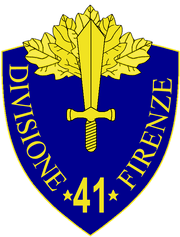41st Infantry Division Firenze
| 41st Infantry Division Firenze | |
|---|---|
|
41st Infantry Division Firenze Insignia | |
| Active | 1939–1943 |
| Country | Italy |
| Branch | Italian Army |
| Type | Infantry |
| Size | Division |
| Garrison/HQ | Florence |
| Nickname(s) | Firenze |
| Engagements |
World War II Italian invasion of France Greco-Italian War Invasion of Yugoslavia |
| Insignia | |
| Identification symbol |
|
| Identification symbol | Firenze Division collar insignia |
The 41st Infantry Division Firenze was an infantry division of the Italian Army during World War II. It was formed 15 September 1939 in Florence and was officially dissolved 28 September 1943.[1]
The division was made up of Tuscans, and especially Florentines (a rare case of Italian Infantry Division whose name coincides with the ethnicity or place of residence of its members).
Actions
7 June 1940, the Firenze division was assigned a police duties in Piedmont region, as part of the Army Group Reserve. The garrisons were established in Carmagnola, Poirino, Villanova d'Asti and remained in place during entire Italian invasion of France.
Around 12 March 1941, the division have received orders to relocate to Albania where it arrived to staging area north-west of Lake Ohrid, near Librazhd by 27 March 1941. The Firenze has moved 1 April 1941 to the border with Yugoslavia, from Stëblevë to north. It was assigned to the right flank of the planned advance from Rrapun (Rapun) river valley north of Librazhd. To support the attack, the Firenze division dug around Shkumbin river valley. First fight has started 8 April 1941, when Yugoslavian forces have tried to attack a mountaintop positions at Mali i Gjinovecit. 9 April 1941, the Firenze division counter-attacked and reached beyond the border by pincer movement in Dibër County, capturing Ostreni i Vogël while blocked in the rest of Ostren. With the part of the Yugoslavian forces surrounded, detachments of the Firenze division have reached Black Drin river bridge in the same day, encountering heavy resistance on the way. The Yugoslavian pocket in Dibër County was eliminated with the fall of Shupenzë 11 April 1941. Subsequently, the Firenze division have advanced to south and captured Maqellarë and Debar 12 April 1941, without encountering much resistance. 14 April 1941, it started to prepare a defensive positions at Kovashicë, Stushaj, and Bllacë. In the same day, the German forces advancing from Gostivar and Kičevo have linked with the Firenze division, ending the fighting.
The Firenze division remained in Macedonia and Montenegro as an occupation force, establishing initially a garrisons at Debar, Struga, Izvor and Volko Legalo. Starting from July, 1941, the division was effectively dismembered, being used for numerous road patrols and small garrisons. By the January, 1943, the Firenze division units were operating mostly in Gostivar, Peshkopi, Burrel, Debar, Struga, Mogorče, Elbasan, Librazhd and Qukës.
Following the Armistice of Cassibile 8 September 1943, a desperate attempt was made to gather the division and retreat to Albania. The Burrel has become a staging area. The re-assembled division, under his commanding general Arnaldo Azzi, moved to Krujë via mountain passes of Qafa e Shtamës. In Krujë, it was opposed by a number of German and Albanian units. Unable to proceed, the Firenze division have retreated to Qafa e Shtamës and started a negotiations. 28 September 1943, the agreement was reached, with majority of division joining the Yugoslav Partisans and Albanian Partisans, been split into four guerilla brigades operating from Qafa e Shtamës to Debar. The 92. CCNN Legion continued to serve with the German forces.[2]
Order of battle
- 127. Firenze Infantry Regiment
- 128. Firenzi Infantry Regiment
- 41. Artillery Regiment
- 92. CCNN Legion (Blackshirts)
- 41. Mortar Battalion
- 241. Anti-Tank Company
- 41. Signal Company
- 53. Pioneer Company
- 37. Medical Section
- 36. Supply Section
- 12. Field Bakery
- 194. Motor Transport Section [nb 1][2]
Notes
- Footnotes
- ↑ An Italian Infantry Division normally consisted of two Infantry Regiments (three Battalions each), an Artillery Regiment, a Mortar Battalion (two companies), an Anti Tank Company, a Blackshirt Legion of two Battalions was sometimes attached. Each Division had only about 7,000 men, The Infantry and Artillery Regiments contained 1,650 men, the Blackshirt Legion 1,200, each company 150 men.[3]
- Citations
- ↑ http://www.regioesercito.it/reparti/fanteria/rediv41.htm
- 1 2 Wendal, Marcus. "Italian Army". Axis History. Retrieved 2009-04-24.
- ↑ Paoletti, p 170
- Paoletti, Ciro (2008). A Military History of Italy. Greenwood Publishing Group. ISBN 0-275-98505-9.
